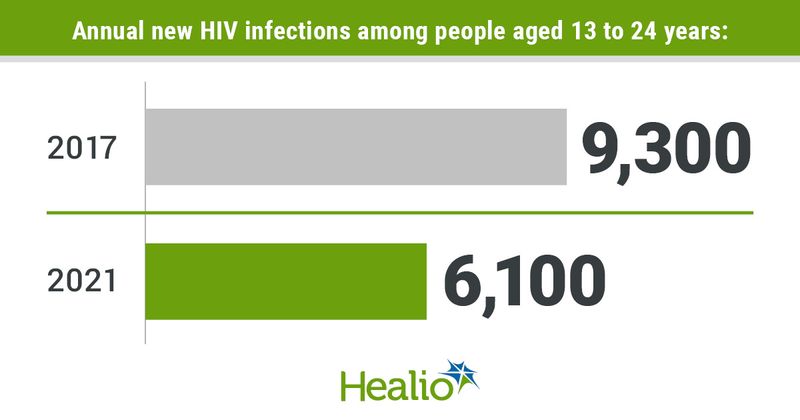Decline in new HIV infections led by large decrease among young people, CDC data show
Key takeaways:
- There were 12% fewer new HIV infections in the U.S. in 2021 compared with 2017, CDC data showed.
- The decrease was driven by a large decline in new infections among people aged 13 to 24 years.
New HIV infections in the United States declined by around 12% from 2017 to 2021, led by large decreases among young people, according to CDC data published Tuesday.
Overall, new infections fell from 36,500 to 32,100, according to the new data. There was a more than 34% decrease in new infections among 13- to 24-year-olds, with most of that decrease reported among gay or bisexual males. For all patients in that age group, infections dropped from 9,300 in 2017 to 6,100 in 2021.

“In prevention, patience is not a virtue,” Jonathan Mermin, MD, MPH, director of the CDC’s National Center for HIV, Viral Hepatitis, STD, and TB Prevention, said in a press release. “Decreasing HIV incidence among youth, including young gay and bisexual males, shows us what is possible. But ending the HIV epidemic and achieving equity requires we expand this progress to all.”
According to the CDC, “the greatest improvement” in prevention indicators was an increase in the proportion of at-risk people taking PrEP to prevent HIV, from 13% in 2017 to 30% in 2021.
However, the agency noted that although most people who could benefit from PrEP are Black and Hispanic/Latino, uptake has not been good, with only 11% of eligible Black patients and 21% of eligible Hispanic patients using PrEP, compared with 78% of eligible white patients.
Most new HIV infections in 2021 were among gay and bisexual men — the majority of them Black or Hispanic. Around one-fifth of new infections occurred among women — half of them Black women.
“At least three people in the U.S. get HIV every hour — at a time when we have more effective prevention and treatment options than ever before," Robyn Neblett Fanfair, MD, MPH, acting director of the CDC’s Division of HIV Prevention, said in the release. “These tools must reach deep into communities and be delivered faster to expand progress from some groups to all groups.”
The CDC outlined three priorities to end the HIV epidemic, including increasing investments in proven prevention programs, maximizing innovations by expanding self-testing and settings to reach patients with HIV services and centering equity in “every aspect of our work, so that HIV prevention interventions better reach people who are disproportionately affected by HIV.”
CDC director Rochelle P. Walensky, MD, MPH, said the report was a sign that the “nation’s HIV prevention efforts continue to move in the right direction” but still requires more effort.
“Longstanding factors, such as systemic inequities, social and economic marginalization and residential segregation, however, stand between highly effective HIV treatment and prevention and people who could benefit from them,” Walensky said. “Efforts must be accelerated and strengthened for progress to reach all groups faster and equitably.”
References:
CDC. Estimated HIV incidence and prevalence in the United States, 2017-2021. http://www.cdc.gov/hiv/library/reports/hiv-surveillance.html. Published May 23, 2023. Accessed May 23, 2023.
CDC. Monitoring selected national HIV prevention and care objectives by using HIV surveillance data – United States and 6 dependent areas, 2021. http://www.cdc.gov/hiv/library/reports/hiv-surveillance.html. Published May 23, 2023. Accessed May 23, 2023.
